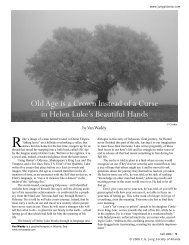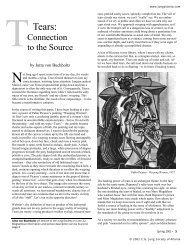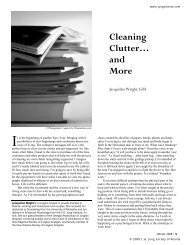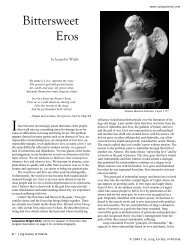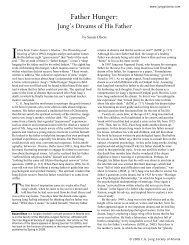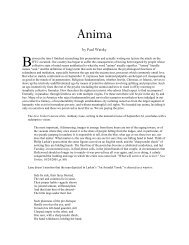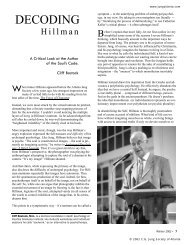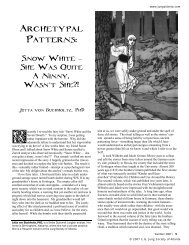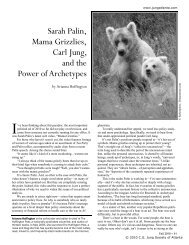Hermes and the Creation of Space - C.G. Jung Society of Atlanta
Hermes and the Creation of Space - C.G. Jung Society of Atlanta
Hermes and the Creation of Space - C.G. Jung Society of Atlanta
You also want an ePaper? Increase the reach of your titles
YUMPU automatically turns print PDFs into web optimized ePapers that Google loves.
function properly. By keeping <strong>Hermes</strong> out <strong>of</strong> <strong>the</strong> ego <strong>and</strong> refusing to make him ego-syntonic, we<br />
acknowledge our dependency upon archetypal powers even for our most mundane daily activities.<br />
In <strong>the</strong> agora <strong>and</strong> not only at a crossroads in <strong>the</strong> wilderness, at home <strong>and</strong> not only at <strong>the</strong> gate <strong>of</strong> <strong>the</strong><br />
sacred temenos, <strong>Hermes</strong> is present. The archetypes undergird <strong>the</strong> ego in all <strong>of</strong> its activities <strong>and</strong><br />
functions. This is a key to perceiving sacredness in everyday life.<br />
<strong>Hermes</strong> <strong>and</strong> <strong>the</strong> Instinct <strong>of</strong> Creativity<br />
The erect phallus on <strong>Hermes</strong> monuments has perplexed scholars <strong>and</strong> amused tourists. Burkert says<br />
that a "form <strong>of</strong> territorial demarcation, older than man himself, is phallic display, which is <strong>the</strong>n<br />
symbolically replaced by erected stones or stakes. To this extent, stone cairn <strong>and</strong> apotropaic<br />
phallos have always gone toge<strong>the</strong>r" (1985 p. 156). Burkert, who seems to be a keen student <strong>of</strong><br />
animal behavior <strong>and</strong> ethological studies, connects <strong>the</strong> phallicism <strong>of</strong> Herms to <strong>the</strong> phallic display <strong>of</strong><br />
a certain species <strong>of</strong> monkeys: "...<strong>the</strong>y sit up at <strong>the</strong> outposts, facing outside <strong>and</strong> presenting <strong>the</strong>ir<br />
erect genital organ.... every individual approaching from <strong>the</strong> outside will notice that this group<br />
does not consist <strong>of</strong> helpless wives <strong>and</strong> children, but enjoys <strong>the</strong> full protection <strong>of</strong> masculinity"<br />
(1982, p. 40).<br />
To me this emphasis on <strong>Hermes</strong>' protective role <strong>and</strong> on <strong>the</strong> use <strong>of</strong> Herms to br<strong>and</strong>ish claims <strong>of</strong><br />
territoriality seems interesting but far-fetched. It is one thing to say that <strong>Hermes</strong> st<strong>and</strong>s at<br />
boundaries <strong>and</strong> defines space; it is quite ano<strong>the</strong>r to make <strong>of</strong> him a guardian <strong>of</strong> <strong>the</strong> gate. This is not<br />
usually seen to be his role. Cerberus guards <strong>the</strong> gates <strong>of</strong> Hades, not <strong>Hermes</strong>. And Apollo would be<br />
insulted to realize that one supposed <strong>Hermes</strong> was needed to guard <strong>the</strong> gates <strong>of</strong> his sacred precincts<br />
on Delos. <strong>Hermes</strong> is a thief, not a guard. Burkert has to admit: "That a monument <strong>of</strong> this kind<br />
could be transformed into an Olympian god is astounding" (1985, p. 156).<br />
The answer is <strong>of</strong> course that <strong>Hermes</strong> was a god long before <strong>the</strong> Herm was constructed. He is<br />
archaic <strong>and</strong> primordial. But so is territory <strong>and</strong> <strong>the</strong> sense <strong>of</strong> territoriality. Yet it was not <strong>Hermes</strong>'<br />
management <strong>of</strong> <strong>the</strong> territorial imperative that placed him on Olympus. It was his connection to <strong>the</strong><br />
source <strong>of</strong> life, to archetype <strong>and</strong> instinct, to <strong>the</strong> self. <strong>Hermes</strong> states creativity. It seems to me that a<br />
better explanation for <strong>the</strong> presence <strong>of</strong> <strong>the</strong> erect phallos on <strong>Hermes</strong>' monuments has to do with his<br />
deep <strong>and</strong> indeed essential association with <strong>the</strong> instinct <strong>of</strong> creativity.<br />
Creativity is highlighted in a number <strong>of</strong> tales <strong>and</strong> emphasized by some scholars as a major<br />
attribute <strong>of</strong> this god. Along with Hephaistos <strong>and</strong> Prome<strong>the</strong>us, <strong>Hermes</strong> was loved <strong>and</strong> honored by<br />
craftsmen. The sheer rampant energy <strong>of</strong> creativity sounds through <strong>the</strong> image <strong>of</strong> <strong>Hermes</strong> as he is<br />
classically presented in <strong>the</strong> Homeric Hymn. In <strong>the</strong> Hymn to <strong>Hermes</strong> we hear <strong>of</strong> <strong>the</strong> new-born baby<br />
creating <strong>the</strong> lyre from a tortoise shell on <strong>the</strong> first day <strong>of</strong> his life. Later he is credited with <strong>the</strong><br />
discovery <strong>of</strong> starting fire by rubbing sticks toge<strong>the</strong>r <strong>and</strong> with <strong>the</strong> invention <strong>of</strong> <strong>the</strong> pipes. The sheer<br />
joy <strong>and</strong> delight he experiences at his own quick <strong>and</strong> sure inventiveness are infectious as one reads<br />
or listens to <strong>the</strong> Hymn. This has reminded some readers <strong>of</strong> <strong>the</strong> gleam in <strong>the</strong> craftsman's eye as he<br />
forges a new device or solves a practical problem (cf. Brown, p. 79). You can hear this joyous<br />
craftsman's energy in Wagner's rendition <strong>of</strong> Siegried hammering his sword into shape in <strong>the</strong> third<br />
opera <strong>of</strong> <strong>the</strong> Ring cycle.<br />
After his successful struggle with Apollo to attain equal rank - interpreted to represent <strong>the</strong> rise <strong>of</strong><br />
craftsmen in ancient Greece <strong>and</strong> <strong>the</strong>ir seizure <strong>of</strong> equality with <strong>the</strong> aristocracy <strong>of</strong> A<strong>the</strong>ns (cf.<br />
Brown, pp.79ff.) - <strong>Hermes</strong> is given equality in <strong>the</strong> arts with Apollo, <strong>the</strong> great god <strong>of</strong> poetry, music,<br />
dance <strong>and</strong> o<strong>the</strong>r artistic activities in ancient Greece. <strong>Hermes</strong> claims in <strong>the</strong> Hymn that he is a<br />
follower <strong>of</strong> Mnemosyne, <strong>the</strong> goddess <strong>of</strong> memory, <strong>and</strong> her daughters <strong>the</strong> Muses (hence his<br />
appearance in Botticelli's famous painting, Spring). His essential association with <strong>the</strong> instinct <strong>of</strong><br />
creativity must be granted.




